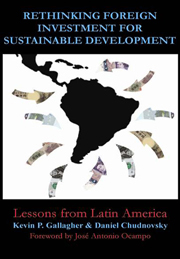Book contents
- Frontmatter
- Contents
- List of Figures
- List of Tables
- Foreword
- Acknowledgements
- Author Biographies
- Rethinking Foreign Investment for Sustainable Development
- 1 FDI and Sustainable Development in the Americas
- 2 Is Foreign Investment Always Good for Development?
- Part 1 Country Assessments
- 3 Islands of Possibility: MNCs and Economic Development in Brazil
- 4 Foreign Investment: The Polarization of the Mexican Economy
- 5 A Missed Opportunity: Foreign Investment and Sustainable Development in Argentina
- 6 Foreign Investment and Economic Development in Costa Rica: The Unrealized Potential
- Part 2 Political Economy of Natural Resources and The Environment
- Notes
- References
- Index
6 - Foreign Investment and Economic Development in Costa Rica: The Unrealized Potential
from Part 1 - Country Assessments
Published online by Cambridge University Press: 05 March 2012
- Frontmatter
- Contents
- List of Figures
- List of Tables
- Foreword
- Acknowledgements
- Author Biographies
- Rethinking Foreign Investment for Sustainable Development
- 1 FDI and Sustainable Development in the Americas
- 2 Is Foreign Investment Always Good for Development?
- Part 1 Country Assessments
- 3 Islands of Possibility: MNCs and Economic Development in Brazil
- 4 Foreign Investment: The Polarization of the Mexican Economy
- 5 A Missed Opportunity: Foreign Investment and Sustainable Development in Argentina
- 6 Foreign Investment and Economic Development in Costa Rica: The Unrealized Potential
- Part 2 Political Economy of Natural Resources and The Environment
- Notes
- References
- Index
Summary
Introduction
After a long history of dependence on a few traditional exports, followed by import substitution in the 1960s and 1970s, and a debt crisis in the early 1980s, Costa Rica launched an aggressive attempt at diversifying production and exports in 1985. The new approach to development consisted of two main elements: pursuit of free trade agreements and the attraction of foreign direct investment (FDI). Costa Rica has been remarkably successful in attracting FDI. It is the only country in Latin America where most FDI has gone to manufacturing over the last decade, and it stands out even further for its ability to attract FDI in high-tech sectors.
In this article we analyze why Costa Rica was an attractive destination for transnational corporations (MNCs), and the impact FDI has had on economic development in the country. We show that FDI in the Free Zones has had a beneficial impact primarily at the macroeconomic level, through employment and trade balance effects. At the microeconomic level, however, the impact has been rather limited as backward linkages and technological spillovers are small in both absolute and relative terms.
The limited extent of backward linkages from FDI is due to the limited potential for spillovers for part of the foreign investment as well as to the limited domestic absorptive capacity for linkages. Ultimately, we argue, the lack of a coherent long-term development strategy has hindered the ability of the country to take more advantage of high-tech FDI.
- Type
- Chapter
- Information
- Rethinking Foreign Investment for Sustainable DevelopmentLessons from Latin America, pp. 97 - 124Publisher: Anthem PressPrint publication year: 2009
- 5
- Cited by



